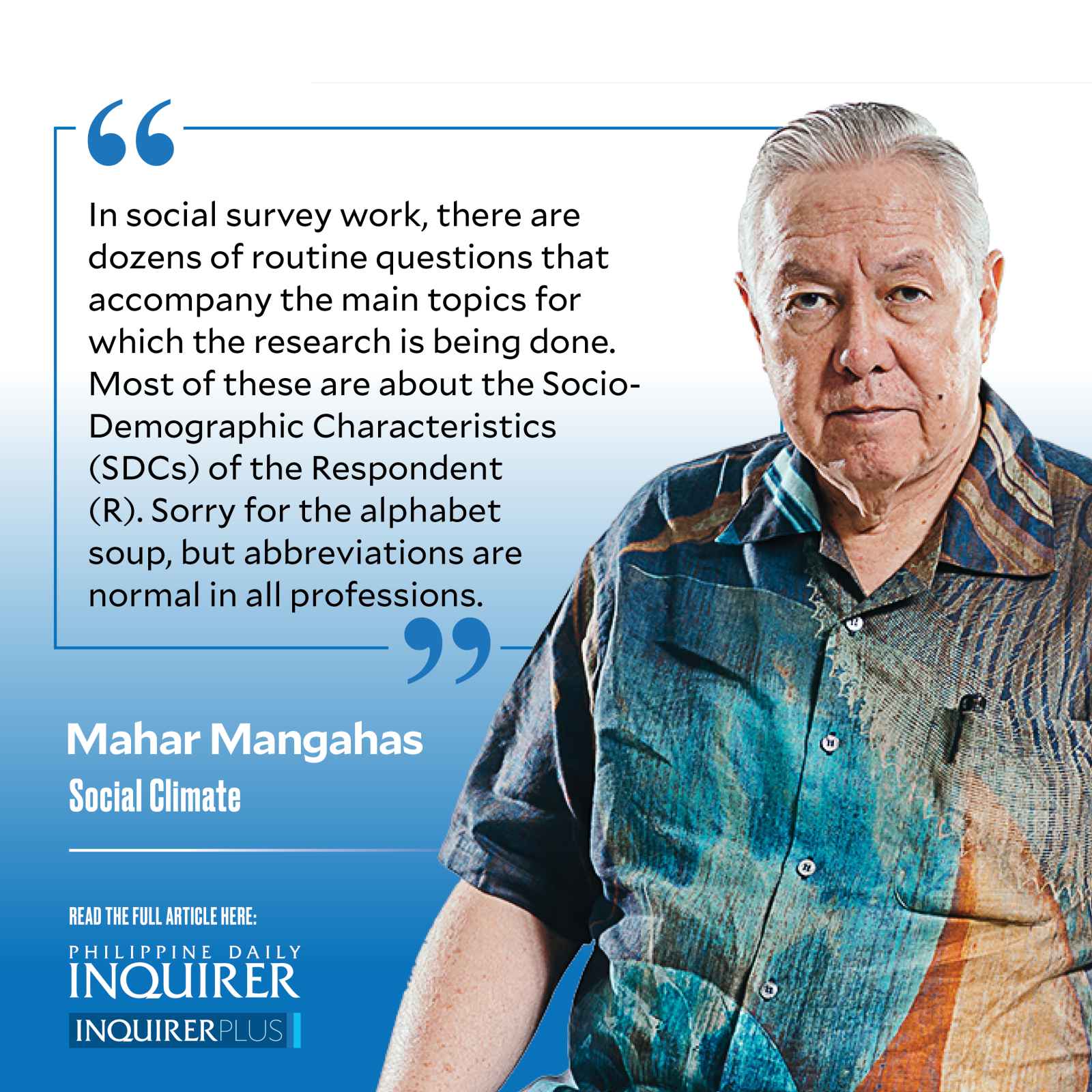Routine demographics
Recently, on my first visit to a cardiologist, his secretary immediately took my height, weight, blood pressure, and temperature, and then showed me where to sit and wait for him to be free; that’s the routine. Being in the data biz myself, I know better than to question the use of such items in a physician’s field.
In social survey work, there are dozens of routine questions that accompany the main topics for which the research is being done. Most of these are about the Socio-Demographic Characteristics (SDCs) of the Respondent (R). Sorry for the alphabet soup, but abbreviations are normal in all professions.
A standard SWS surveys has two Rs: one is the household head (HHH), who answers questions that refer to the household as a whole, and the other is the probability respondent (PR), an adult chosen at random from the household members—sometimes the same person as the HHH—who tells of his/her personal well-being and knowledge and attitudes about the current social, economic, or political situation. The HHH and the PR each have a routine SDC questionnaire, aside from their main questionnaires dealing with the survey’s main interest.
The HHH is whoever is recognized as such in the household, and not necessarily the husband in the main nuclear family. In fact, the proportion of female HHHs has steadily grown over time, from close to 30 percent three decades ago to close to 50 percent nowadays. (Yet, in the Philippines, poverty and hunger—as seen from below—are no worse in female-headed households than in male-headed ones, unlike in other countries, where spouse abandonment is rampant.)
Every questionnaire item in an SWS survey is routinely tabulated by the R’s area (National Capital Region, Balance Luzon, Visayas, and Mindanao), locale (urban versus rural—as encountered in the field, not as officially classified, which gets outdated), dwelling class (ABC/D/E; see “Social classes seen from below,” 9/17/22), sex (male and female, in the cis-sense), age (18-24, 25-34, 35-44, 45-54, and 55+; assuming a survey of adults), and educational attainment (incomplete elementary; incomplete junior high school; incomplete senior high school; up to some college; college graduate). We call these the Primary Data Tables (PDTs); hard copy is on file.
Incidentally, we’ve probed a few times on whether an R would prefer a different cisgender (the Yes’s are 5-7 percent, as I recall; this—and any other result—can be checked from the archive). I wonder if it is time to consider asking about transgender etcetera.
An incomplete list of other routine SDC items: household composition (by number of families and by number of adults and children; religion; marriage status (the formally married proportion seems dropping); home-lot ownership (sometimes we use this to separate dwelling class D into class D1 and class D2); home facilities—piped water, type of toilet (very little upgrading from “de buhos” to flush-toilets), electricity, landlines (declining), cellular phones (“smart”?), tablets (with internet?), radio, television (with cable?), personal computer (with internet?), personal email address, motor vehicles (two, three, or four-wheeled?), bicycles (with sidecar?), motorized boats/bancas; labor force status and profile (a very large array of items, including doing work, seeking work, type of employer, and overseas work by absent family members and remittances from them); language spoken at home; language of the oral survey interview; language of the written questionnaire (normally it has five language-versions).
Joblessness (absence of regular paid work) has always been much higher among women than men—but of course women contribute very much to family well-being through their work in the home. Joblessness has always decreased with age. The prevalence of overseas worker/s seems to be declining.
So much data routinely gathered, aside from the main interest of the survey? Well, unlike in the cardiologist’s clinic, we implement the main questionnaires first and ask for the demographics later. The latter are uncontroversial and easy to answer. The interview ends by asking—“How do you feel about the interview?”—which is answered by choosing from 12 emojis. We are gratified that at least three-fourths choose the smiley face or some other positive reaction!
——————
Contact: mahar.mangahas@sws.org.ph
###—###
#ColumnName
Social Climate
Mahar Mangahas





















